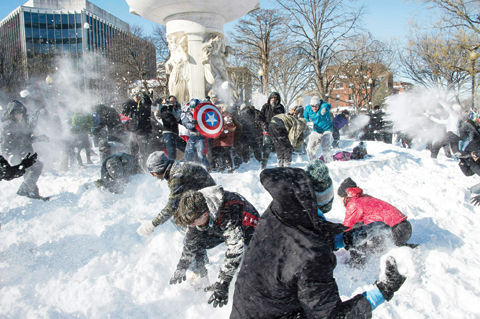 WASHINGTON: People take part in the DC Snowball Fight at Dupont Circle yesterday. Snowball fights have become a tradition after every major snowstorm in the US capital. — AFP
WASHINGTON: People take part in the DC Snowball Fight at Dupont Circle yesterday. Snowball fights have become a tradition after every major snowstorm in the US capital. — AFPNEW YORK: Millions of people in the eastern United States started digging out yesterday from a huge blizzard that brought New York and Washington to a standstill, but the travel woes were far from over. The storm - dubbed "Snowzilla" - killed at least 18 people after it walloped several states over 36 hours on Friday and Saturday, affecting an estimated 85 million residents who were told to stay off the roads and hunker down in doors for their own safety.
Forecasters said the storm dumped more than 22 inches (56 cm) of snow on the paralyzed capital Washington and the 26.8 inches that fell in New York's Central Park was the second-highest accumulation in the city since records began in 1869. Near-record-breaking snowfall was also reported in other major cities up and down the US East Coast, with Philadelphia and Baltimore also on the receiving end of some of the worst that Mother Nature could fling at them.
With the storm finally tapering off overnight, officials in New York lifted a travel ban at 7:00 am Sunday (1200 GMT), restoring access to roads throughout the city and in Long Island and New Jersey. "You never like to disrupt transportation and commerce. However, the storm was fast and furious," said New York State Governor Andrew Cuomo. "So far, so good, but we have more work to do."
Forecasters were predicting an altogether more forgiving outlook for the remainder of the weekend in New York and Washington - blue skies and sunshine with temperatures hovering at about zero Celsius. However, there were concerns about lingering strong winds and melting snow, with streets in some New Jersey coastal towns filled with water and ice, raising the specter of flooding and dangerous black ice.
"This system dumped copious amounts of snow over West Virginia, Virginia, Washington DC, Maryland, Pennsylvania, New Jersey and New York. A few locations came close to, or surpassed all-time one-day and two-day snow records," said the National Weather Service. The fatalities occurred in Arkansas, Kentucky, New York, North Carolina, Maryland and Virginia, while more than 200,000 people were left without power at the height of the storm.
'Please be Careful'
Despite the generally better weather outlook, for many the hard work was just beginning and there was no immediate end in sight to the misery for thousands of air passengers. Nearly 3,500 domestic and international flights were canceled yesterday, adding to a growing backlog that had built up at major airports in New York, Philadelphia, Washington and Baltimore, which all ground to a halt at the height of the wintry onslaught.
Authorities said they were working around the clock to restore operations, with the first arrivals and departures expected later in the day in New York. But Reagan National and Dulles International airports in the US capital were expected to remain closed through yesterday, and buses and the metro system were also not due to return to action until today.
Back on the streets, plows struggled to clear large mounds of snow in an attempt to get New York and the eastern portion of the US back on its feet as soon as possible. Parked cars were buried under heavy snow and sidewalks were still impassable in places, as authorities scrambled to clear away the deluge for the start of the working week. "People want to start to go outside and start shoveling and clearing their walks and driveways," said New Jersey Governor Chris Christie, a Republican presidential contender who left the campaign trail to oversee the emergency response in his state. "This is very heavy snow so I ask that they please be careful as they clean up their own property today or their businesses."
It was not just the major cities that were hard hit. Snow and sleet also buffeted the southern states of Arkansas, Tennessee, Kentucky, North Carolina, West Virginia and Virginia - unusual for the region. Nearly 150,000 power outages were reported in North Carolina alone at the height of the storm, emergency officials said. Yesterday, that number had been whittled down to about 50,000. - AFP










